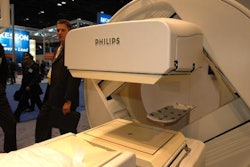Although bone scintigraphy is one of the more widely used nuclear medicine studies, interpreting the images is time-intensive, and detecting interval changes can be problematic.
Researchers from the Kurt Rossmann Laboratories for Radiologic Image Research in the department of radiology at the University of Chicago in Illinois have developed a computerized temporal subtraction technique used between successive whole-body bone scans that may reduce physicians' reading time and improve their accuracy.
"Although the sensitivity of bone scans for detecting bone abnormalities is high, it can be time-consuming to identify and evaluate multiple lesions such as with innumerable bone metastases of prostate or breast cancers," the authors wrote in poster presentation exhibited at the 2006 RSNA conference in Chicago.
The scientists created a three-step computerized process for conducting temporal subtraction between two successive bone scans. The first step normalizes the image grayscale by using average pixel values for normal bone structure. The second step matches the size, orientation, and grayscale of a previous image to that of the current image. The third step involves applying a nonlinear image-warping technique to the matched image, which reduces misregistration artifacts in the temporal subtraction image, the authors reported.
"Bone scan images generally have a very high target (bone)-to-background ratio and a very homogeneous and symmetric distribution of normal activity compared with other types of whole-body images, thus making them well suited for subtraction techniques," they wrote.
The study of the technique utilized 20 pairs of successive whole-body bone scans with both posterior and anterior views. A group of five radiologists conducted two separate reading sessions with at least two weeks in between sessions.
In the first reading session, the radiologists marked lesion locations and delivered confidence ratings for interval changes on 20 pairs of previous and current images without temporal subtraction processing. The second reading session added the temporal subtraction images, along with the modified previous and current images.
According to the study team, the average sensitivity in detecting interval changes was improved from 58.6% to 73.2% utilizing the temporal subtraction images, with a false-positive rate of 2.0 per case.
Reading time also showed a significant improvement with the use of the computerized temporal subtraction technique. The mean reading time per case for all the radiologists using the processing was 91 seconds, compared with a mean of 134 seconds for the unprocessed image sets.
"In addition, the individual reading time for each radiologist was reduced significantly for four of the five radiologists, with more than a 20% reduction in reading times," the authors wrote.
The researchers noted that slight artifacts in subtraction occurred due to changes in patient position, particularly in the extremities or head, or bladder or renal collecting system size differences. However, on the basis of the results of the study, the scientists believe the temporal subtraction processed images are readily interpretable.
By Jonathan S. Batchelor
AuntMinnie.com staff writer
January 4, 2007
Related Reading
Scintigraphy pegs potential responders to plantar fasciitis treatment, October 25, 2006
F-18 fluoride PET/CT accurately detects bone metastases in high-risk prostate cancer, March 10, 2006
Bone SPECT identifies patients who would benefit from facet joint injection, February 15, 2006
SPECT/CT helps clarify ambiguous bone foci, February 9, 2006
MDCT staging may obviate bone scintigraphy in some patients, March 6, 2005
Copyright © 2007 AuntMinnie.com




















